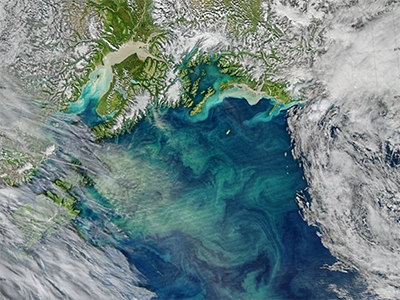Invitation for Special Issue of Remote Sensing: Retrieving Marine Inherent Optical Properties and Biogeochemistry from Hyperspectral Measurements
April 2019Guest editors Dr. Jeremy Werdell and Dr. Timothy Moore invite you to submit papers to this special issue (described below). Submissions will be considered through April 2019.
Ocean color satellite instruments provide daily observations of the upwelling spectral light field from which estimates of marine inherent optical properties (IOPs) are generated. The spectral absorption and backscattering coefficients of the surface water column are the two prime IOPs that describe the contents of the upper ocean, information critical to furthering scientific understanding of biogeochemical processes such as carbon exchanges, phytoplankton biodiversity shifts, and aquatic biogeochemistry responses to climatic disturbances. As such, the international community has invested significant effort into ensuring and improving the quality of determining IOPs from in situ measurements, bio-optical models, and ultimately, from ocean color satellite radiometry.
Upcoming satellite missions, such as the NASA Plankton, Aerosols, Clouds, ocean Ecosystem (PACE) mission, will provide far more spectral information than their predecessors. The planned PACE instrument payload will provide continuous spectra at ~5-nm resolution across the light spectrum from the ultraviolet through the near-infrared, a substantial increase over heritage satellite radiometers that provided only several wavebands in this domain. Instrument and algorithm advances are needed to support and take advantage of the new information available from the expected near hyperspectral signal from PACE. It follows that the time is right to pursue novel methods for deriving marine IOPs and aquatic biogeochemical parameters from hyperspectral measurements of ocean color. This Special Issue will highlight how space-borne spectroscopy can improve the quality of remotely-sensed bio-optical and biogeochemical data products.
We are inviting submissions including, but not limited to, the derivation of the following from hyperspectral ocean color:
Dr. Jeremy Werdell
Dr. Timothy Moore
Guest Editors
Keywords:
ocean color, satellite remote sensing, radiative transfer theory, bio-optics, aquatic biogeochemistry, phytoplankton, community composition, inherent optical properties, spectroscopy, semi-analytical algorithms, derivative analyses, PACE
For more information, visit the issue description. Remote Sensing
Ocean color satellite instruments provide daily observations of the upwelling spectral light field from which estimates of marine inherent optical properties (IOPs) are generated. The spectral absorption and backscattering coefficients of the surface water column are the two prime IOPs that describe the contents of the upper ocean, information critical to furthering scientific understanding of biogeochemical processes such as carbon exchanges, phytoplankton biodiversity shifts, and aquatic biogeochemistry responses to climatic disturbances. As such, the international community has invested significant effort into ensuring and improving the quality of determining IOPs from in situ measurements, bio-optical models, and ultimately, from ocean color satellite radiometry.
Upcoming satellite missions, such as the NASA Plankton, Aerosols, Clouds, ocean Ecosystem (PACE) mission, will provide far more spectral information than their predecessors. The planned PACE instrument payload will provide continuous spectra at ~5-nm resolution across the light spectrum from the ultraviolet through the near-infrared, a substantial increase over heritage satellite radiometers that provided only several wavebands in this domain. Instrument and algorithm advances are needed to support and take advantage of the new information available from the expected near hyperspectral signal from PACE. It follows that the time is right to pursue novel methods for deriving marine IOPs and aquatic biogeochemical parameters from hyperspectral measurements of ocean color. This Special Issue will highlight how space-borne spectroscopy can improve the quality of remotely-sensed bio-optical and biogeochemical data products.
We are inviting submissions including, but not limited to, the derivation of the following from hyperspectral ocean color:
- Absorption by phytoplankton, non-algal particles, and CDOM
- Backscattering by phytoplankton and non-algal particles
- Phytoplankton community composition, including harmful algal blooms
- Phytoplankton physiological parameters
- Carbon stocks and processes
- Indices of water quality for watershed management (e.g., light penetration and turbidity)
- Atmospheric (correction) parameters that improve estimates of remote-sensing reflectance
Dr. Jeremy Werdell
Dr. Timothy Moore
Guest Editors
Keywords:
ocean color, satellite remote sensing, radiative transfer theory, bio-optics, aquatic biogeochemistry, phytoplankton, community composition, inherent optical properties, spectroscopy, semi-analytical algorithms, derivative analyses, PACE
For more information, visit the issue description. Remote Sensing


